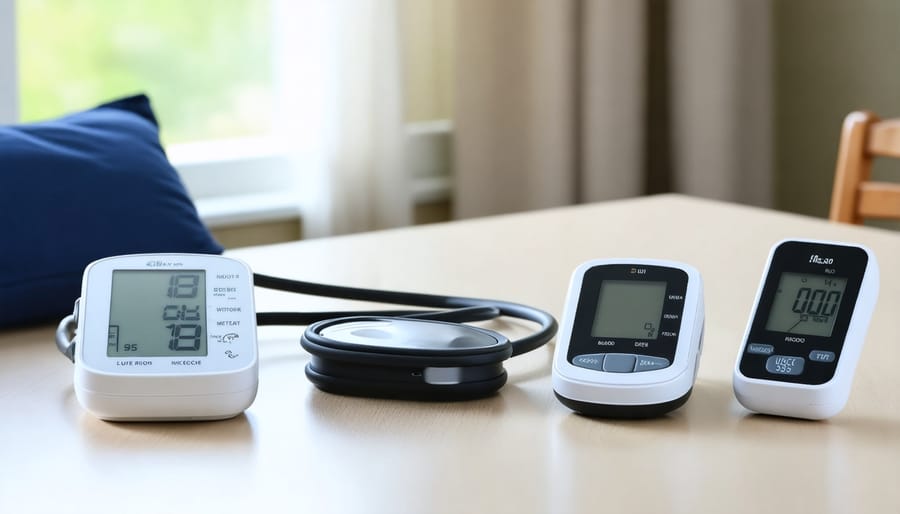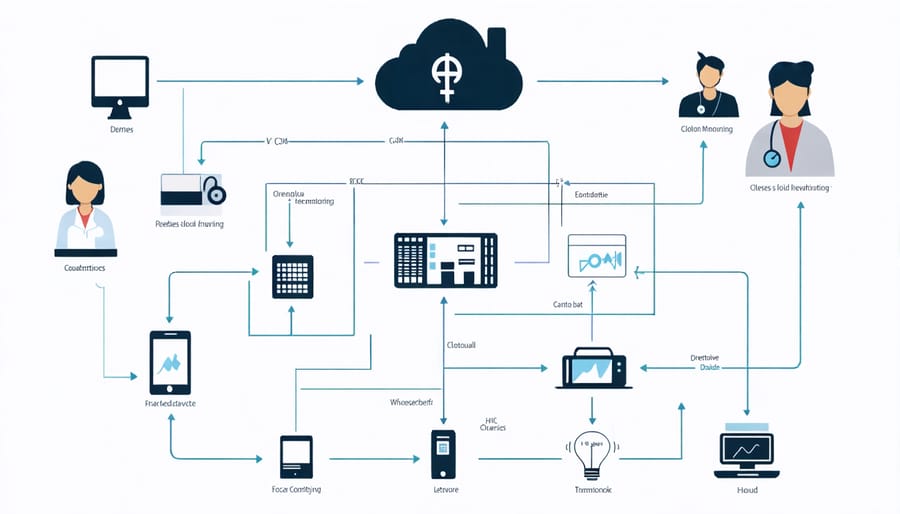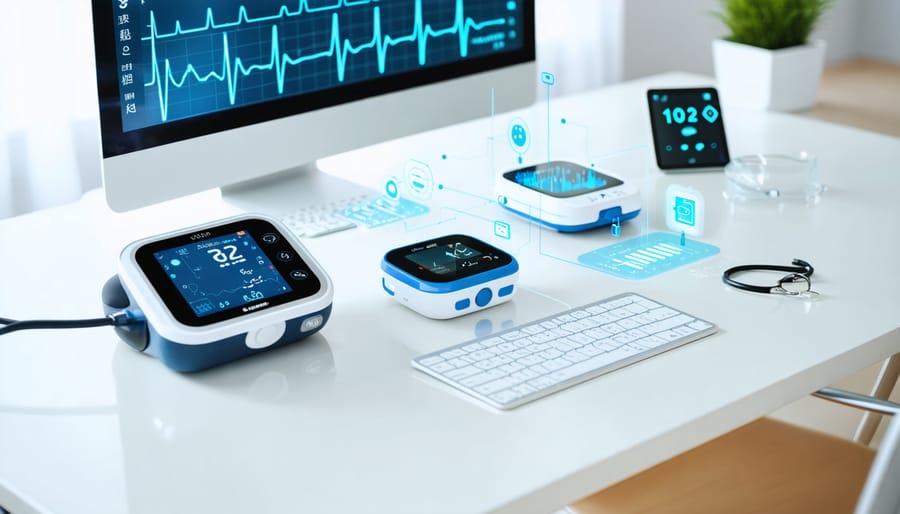Transform your healthcare experience today with remote monitoring telemedicine, a revolutionary smart medical technology that brings professional medical care directly into your Alberta home. Track vital signs, manage chronic conditions, and connect with healthcare providers in real-time using secure, Health Canada-approved devices that transmit data directly to your medical team. This modern approach to healthcare has reduced hospital readmissions by 40% and emergency room visits by 30% among chronic disease patients in Alberta.
Remote monitoring empowers you to take control of your health while maintaining close supervision from medical professionals. Whether you’re managing diabetes, heart conditions, or other chronic illnesses, this technology provides peace of mind through continuous monitoring and immediate medical intervention when needed. As healthcare evolves, remote monitoring represents a practical solution for Albertans seeking accessible, efficient, and personalized medical care without frequent clinic visits.
How Remote Health Monitoring Works
Essential Monitoring Devices
Remote monitoring relies on several user-friendly devices that help you track your health from home. The most common device is a digital blood pressure monitor, which provides accurate readings of your heart rate and blood pressure with just the push of a button. For people managing diabetes, smart glucose meters can automatically record and share blood sugar readings with your healthcare team.
Smart scales do more than measure weight – they can track body composition, including muscle mass and hydration levels. Many come with apps that create easy-to-understand health trends over time. For heart health monitoring, portable ECG devices can record your heart rhythm and alert you to potential concerns.
Pulse oximeters, which clip onto your fingertip, measure blood oxygen levels and can be especially important for respiratory conditions. Activity trackers and smartwatches now offer advanced health monitoring features, tracking everything from sleep patterns to irregular heartbeats.
These devices are becoming increasingly affordable and easier to use, with most connecting directly to your smartphone. Your healthcare provider can help you choose the right devices based on your specific health needs and monitoring requirements.

Data Collection and Transmission
Remote monitoring telemedicine uses a variety of smart devices and sensors to collect your health information at home. These devices, which are part of ongoing healthcare technology advancements, can track vital signs like blood pressure, heart rate, blood sugar levels, and even sleep patterns.
Most monitoring devices connect to your smartphone or tablet through Bluetooth. They automatically send your health readings to a secure app, which organizes the information and sends it to your healthcare team. Some common examples include blood pressure cuffs that wirelessly transfer readings, continuous glucose monitors that track blood sugar levels throughout the day, and smart scales that record your weight and body composition.
The data transmission happens through encrypted channels to protect your privacy. Your healthcare provider can access this information through a secure portal, allowing them to track your health patterns over time and spot any concerning changes early. They can then reach out to you if they notice anything that needs attention, often before you might realize there’s an issue.

Benefits for Alberta Patients
Improved Disease Management
Remote monitoring has revolutionized how we manage chronic conditions, making it easier than ever to stay on top of your personalized healthcare journey. Instead of waiting for scheduled appointments to share health updates, continuous monitoring allows your healthcare team to track important vital signs and symptoms in real-time.
For Albertans living with conditions like diabetes, heart disease, or high blood pressure, this means more precise and timely care adjustments. Your healthcare provider can spot concerning trends early and make medication or lifestyle recommendations before small issues become serious problems.
The monitoring process is straightforward: you use home devices to measure things like blood pressure, blood sugar, heart rate, or weight. These readings are automatically sent to your healthcare team through secure apps or devices. This creates a more complete picture of your health than occasional clinic visits alone can provide.
What makes this approach particularly effective is the ability to see patterns over time. For example, you might notice that your blood pressure tends to spike during certain times of day or after specific activities. This valuable information helps you and your healthcare team make more informed decisions about your treatment plan.
Many Albertans find that continuous monitoring helps them feel more confident and in control of their health. It’s like having a safety net that catches potential problems early while encouraging active participation in your own care.
Convenience and Access
Remote monitoring brings healthcare right to your home, eliminating the need for frequent trips to medical facilities. This is especially valuable for Albertans living in rural communities, where the nearest healthcare center might be hours away. Instead of making long journeys for routine check-ups, you can share vital health information with your healthcare team from the comfort of your living room.
The convenience extends beyond just saving travel time. You can take measurements and record health data at various times throughout the day, providing your healthcare providers with a more complete picture of your health patterns. This is particularly helpful for managing conditions like diabetes, high blood pressure, or heart disease, where regular monitoring is crucial.
For working professionals and busy parents, remote monitoring fits seamlessly into daily routines. You can check your vital signs before heading to work, during lunch breaks, or after the kids are in bed. There’s no need to take time off work or arrange childcare for routine monitoring.
Rural Albertans especially benefit from this technology during harsh winter weather when travel can be challenging or dangerous. The system ensures continuous care regardless of road conditions or distance. Plus, many remote monitoring devices can store data offline and sync when internet connection becomes available, making the system practical even in areas with limited connectivity.
This accessibility helps prevent gaps in care and ensures that distance is never a barrier to receiving quality healthcare support.

Getting Started with Remote Monitoring
Talking to Your Healthcare Provider
Having an open conversation with your healthcare provider about remote monitoring is an important first step in your telemedicine journey. Start by scheduling a regular appointment to discuss your health goals and ask if remote monitoring could benefit your specific situation.
Before your appointment, make a list of questions and concerns. Consider asking about the types of vital signs or health data you should track, how often you need to take measurements, and what equipment you’ll need at home. It’s also helpful to mention any technology concerns or limitations you may have.
Be prepared to share your daily routine and lifestyle factors that might affect your ability to use monitoring devices. If you work shift work or travel frequently, let your healthcare provider know so they can recommend the most suitable monitoring schedule.
During the discussion, ask about:
– The cost of equipment and if it’s covered by Alberta Health Care
– How your data will be collected and stored
– Who will review your readings and how often
– What numbers or symptoms should prompt immediate contact
– How quickly you can expect responses to concerning readings
– Available training or support for using monitoring devices
Remember to be honest about your comfort level with technology. Many healthcare providers offer detailed training sessions to help you get started with your monitoring devices. They can also connect you with technical support resources if needed.
Setting Up Your Home Monitoring System
Setting up your home monitoring system is simpler than you might think. Start by creating a dedicated space for your medical devices – ideally a quiet, well-lit area where you can take measurements consistently. Make sure this space has a reliable internet connection and is close to an electrical outlet.
First, unpack and familiarize yourself with your prescribed monitoring devices. Common equipment might include a blood pressure monitor, blood glucose meter, pulse oximeter, or weight scale, depending on your healthcare needs. Many of these devices now come with Bluetooth capability to connect directly to your smartphone.
Download your healthcare provider’s recommended monitoring app to your smartphone or tablet. These apps typically guide you through the initial setup and device pairing process. Take time to learn how to input data correctly and understand what the readings mean.
Create a daily routine for taking your measurements. Consistency is key – try to check your readings at the same time each day. Keep a backup paper log in case of technical issues.
Test your setup by doing a trial run with all devices. Share a few readings with your healthcare team to ensure they’re receiving the data correctly. Most importantly, know who to contact if you experience technical difficulties or have questions about your readings.
Remember to keep your devices clean and properly maintained, and always have spare batteries on hand. With proper setup and routine, home monitoring becomes a natural part of your daily healthcare management.
Remote monitoring telemedicine has transformed healthcare delivery, making it more accessible, efficient, and patient-centered than ever before. As we’ve explored throughout this article, this innovative approach to healthcare brings medical supervision right into your home, offering peace of mind and improved health outcomes for Albertans managing chronic conditions or seeking preventive care.
The benefits are clear: reduced hospital visits, better disease management, early detection of health issues, and enhanced communication with healthcare providers. For residents across Alberta, from busy urban professionals in Calgary and Edmonton to those in remote rural communities, remote monitoring provides a practical solution to stay connected with their healthcare team.
Remember, getting started with remote monitoring is simpler than you might think. Begin by discussing options with your healthcare provider, familiarize yourself with the available devices, and take advantage of Alberta’s telemedicine resources. Many insurance plans now cover remote monitoring services, making it an increasingly accessible option for most residents.
As technology continues to advance and healthcare evolves, remote monitoring will play an even more significant role in how we manage our health. Whether you’re managing diabetes, heart disease, or simply want to take a more proactive approach to your wellness, consider exploring remote monitoring options available in your area.
Take the first step toward better health management by reaching out to your healthcare provider about remote monitoring solutions. Your journey to more convenient, effective healthcare starts with a simple conversation about how these tools can work for you.

